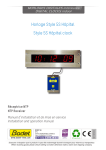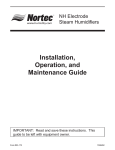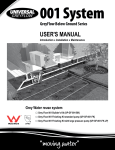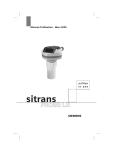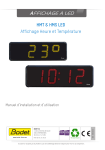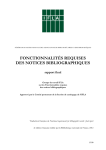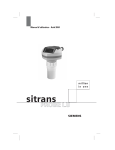Download Notice utilisateur et mise en service Cristalys NTP
Transcript
HORLOGES LCD intérieures LCD CLOCKS indoor Cristalys 7 Cristalys 14 Cristalys Date Cristalys Ellipse Réceptrice NTP Supervisée NTP Supervised receiver www.bodet-time.com BODET SA BP1 49340 TREMENTINES Tél: (+330) 02 41 71 72 99 Fax: (+330) 02 41 71 72 01 Usine de Trémentines Système de Management certifié S’assurer à réception que le produit n’a pas été endommagé durant le transport pour réserve au transporteur. When receiving goods please check nothing is broken otherwise make a claim near shipping company. Réf : 607601 A Manuel d’installation et de mise en service Installation and operating instructions 1 Table des matières I - Vérification initiale 4 1.1 Déballage de l’horloge...........................................................................................................4 1.2 Nettoyage...............................................................................................................................4 1.3 Pré-requis...............................................................................................................................4 II - Présentation des horloges CRISTALYS NTP SUPERVISEES 5 III - Mise en service - Installation 6 3.1 Installation et connexion d’une horloge Simple Face (SF)...................................6 3.2 Connexion d’une horloge Double Face (DF)........................................................8 IV - Mise à l’heure 9 V - Configuration réseau (sortie usine) 9 VI - Menu configuration CRISTALYS 7 & 14 NTP SUPERVISEES 10 VII - Menu configuration CRISTALYS ELLIPSE & DATE NTP SUPERVISEES 12 VIII - Présentation du serveur web 18 8.1 Page d’accueil......................................................................................................18 8.2 Page Configuration réseau...................................................................................19 8.3 Page Configuration heure et synchronisation......................................................20 8.4 Page configuration des alarmes...........................................................................22 8.5 Page système........................................................................................................23 IX - Menu technicien CRISTALYS 7 & 14 NTP SUPERVISEES 24 X - Menu technicien CRISTALYS ELLIPSE & DATE NTP SUPERVISEES 25 XI - Que faire si...? ...Vérifier 26 XII - Caractéristiques techniques CRISTALYS 7 & 14 NTP SUPERVISEES 27 XIII - Caractéristiques techniques CRISTALYS ELLIPSE & DATE NTP SUPERVISEES28 XIV - Annexes 29 14.1 Règle sur la langue utilisée dans le menu de mise à l’heure (mode indépendante uniquement)...............................................................................................................29 14.2 Règle sur l’insertion d’alternance texte....................................................................29 2 Table of contents I - Initial Verification 30 1.1 Unpacking the clock.............................................................................................30 1.2 Cleaning................................................................................................................30 1.3 Pre-requisit............................................................................................................30 II - Introduction to the CRISTALYS NTP SUPERVISED 31 III - Installation 32 3.1 Installation and connection of the Single Face clock (SF)..............................32 3.2 Connection Double Sided clock (DF).................................................................34 IV - Time setting 35 V - Factory configuration 35 VI - Configuration menu CRISTALYS 7 & 14 NTP SUPERVISED 36 VII - Configuration menu CRISTALYS ELLIPSE & DATE NTP SUPERVISED 38 VIII - Web interface 44 8.1 Home page...........................................................................................................44 8.2 Network configuration page.................................................................................45 8.3 Time and synchronisation configuration page....................................................46 8.4 Alarm configuration page....................................................................................48 8.5 System page........................................................................................................49 IX - Technician menu CRISTALYS 7 & 14 NTP SUPERVISED 50 X - Technician menu CRISTALYS ELLIPSE & DATE NTP SUPERVISED 51 XI - What to do if...? ... Check. 52 XII - Technical features CRISTALYS 7 & 14 NTP SUPERVISED 53 XIII - Technical features 54 XIV - Appendix 55 14.1 Rule concerning the language used in the time setting menu...............................55 14.2 Rule about the insertion of text alternation..........................................................55 3 I - Vérification initiale Nous vous remercions d’avoir choisi une horloge BODET. Ce produit a été conçu avec soin pour votre satisfaction d’après les bases qualité ISO9001. Nous vous recommandons, de lire attentivement ce manuel avant de commencer à manipuler l’horloge. Conserver ce manuel pendant toute la durée de vie de votre horloge afin de pouvoir vous y reporter à chaque fois que cela sera nécessaire. Tout usage non conforme à la présente notice peut causer des dommages irréversibles sur l’horloge, et entraîne l’annulation de la garantie. 1.1 Déballage de l’horloge Déballer soigneusement l’horloge et vérifier le contenu de l’emballage. Celui-ci doit comprendre : ■■l’horloge Cristalys et un support mural (clipsé sur l’horloge), ■■le kit de fixation (2 vis + 2 chevilles), ■■une pochette de nettoyage, ■■ce manuel. Note : au dos de l’horloge derrière le support mural, une étiquette signalétique précise la version de l’horloge, la tension d’utilisation, le type d’horloge et diverses autres informations (exemple : la couleur du boîtier de l’horloge). 1.2 Nettoyage Utiliser un produit antistatique identique à celui de la pochette de nettoyage fournie. Ne jamais utiliser d’alcool, d’acétone ou autres solvants susceptibles d’endommager le boîtier et la vitre de votre horloge. 1.3 Pré-requis Pour la mise en service des horloges, vous pourrez installer le logiciel «BODET Detect». Ce logiciel est disponible sur le site internet www.bodet-time.com, en téléchargement gratuit. Note : la prise réseau sur laquelle est connectée l’horloge BODET doit être PoE par l’intermédiaire d’un switch PoE ou d’un injecteur PoE. Nous recommandons les marques suivantes : ■■Injecteurs PoE : Zyxel, Tp Link, D-Link, HP, Cisco, Axis, ITE Power Supply, PhiHong, Abus, Globtek. ■■Switches PoE : D-Link, HP, Planet, Zyxel, Cisco, NetGear, PhiHong. 4 II - Présentation des horloges CRISTALYS NTP SUPERVISEES Les horloges Cristalys sont des horloges pour l’intérieur. Elles affichent les heures (en mode 12 h ou 24 h) les minutes et la date (suivant les modèles). Elles gèrent automatiquement les changements d’horaires été-hiver. Une fonction ECO permet d’éteindre l’afficheur la nuit de 23 h à 6 h. Elles possèdent trois menus de réglage : ■■le menu de mise à l’heure, ■■le menu configuration, ■■un menu technicien qui est réservé au personnel de maintenance. Les réglages s’effectuent par l’intermédiaire de deux boutons poussoirs [Sel] et [+] placés au dos de l’horloge. Cristalys 7 Reset Touche «Select» Sel. Touche «+» Cristalys Date & Ellipse Cristalys 14 Reset SELECT ∞ C Touche «Select» Touche «+» Sonde température Touche «Select» Touche «+» Sonde température 5 III - Mise en service - Installation Choisir l’emplacement où sera installée l’horloge en privilégiant un endroit exempt de parasites électriques (transformateur, ...). Le réseau informatique doit être PoE (802.3af, classe 3), sinon utiliser un injecteur PoE pour alimenter l’horloge. 3.1 Installation et connexion d’une horloge Simple Face (SF) a. Retourner l’horloge sur une table. ■■ Desserrer la vis de verrouillage antivol. ■■ Pousser en face des 2 flèches le support mural pour le déclipser. ■■ Retirer le support mural placé au dos de l’horloge. b. Raccorder le réseau Ethernet sur la prise RJ45. ■■ Catégorie du câble Ethernet : 4, 5 ou 6 (bâtiments). Dans ce dernier cas, utilisation d’une prise murale femelle avec un petit cordon RJ45 mâle/mâle souple Le type de synchronisation devra être paramétré dans les pages webserver de l’horloge (voir page 17), notamment l’adresse multicast qui doit être identique à celle du serveur (par défaut 239.192.54.01). Relever l’adresse MAC qui sera utile lors de la détection de l’horloge sur le logiciel Bodet Detect pour la renommer. 50 45,5 143 Cristalys 7 Reset 100 Sel. Vis de verrouillage antivol Mise en place du support de table (option) (Dans les 2 encoches du support mural). 62 252 Reset Cristalys 14 SELECT ∞ C Vis de verrouillage antivol 6 Cristalys Date & Ellipse c. Installation mécanique. ■■ Fixer le support mural à l’aide des chevilles et des vis fournies. ■■ Clipser l’horloge en place sur le support et la bloquer avec la vis de blocage antivol fournie. ■■ Ôter la feuille de protection de la façade, et nettoyer l’horloge à l’aide du chiffon antistatique. Installation sur potence : ■■ Les horloges Cristalys peuvent être installées sur différent types de potence. Référez vous à la notice fournie avec cette potence. 7 3.2 Connexion d’une horloge Double Face (DF) Dans le cas d’une horloge double face, les produits sont fixés dos-à-dos à l’aide d’une potence. a. Pour chaque horloge, desserrer la vis de verrouillage antivol. Pousser en face des 2 flèches le support mural pour le déclipser. Retourner les horloges sur une table. b. Accrochage sur potence : le support s’adapte à la potence simple face et aux potences double face. Utiliser les vis à tôle fournies avec le support. Les points de fixations sont identiques à l’accrochage murale (simple face). c. Raccordement du réseau Ethernet : Un seul câble réseau (RJ45) doit être câblé pour deux horloges en double face. Important : il est impossible de connecter deux Opalys 14 en double face (la consommation dépasse la puissance max du PoE). ■■ Horloge «maître» : Voir chapître 3.1 Installation et connexion d’une horloge Simple Face. ■■ Horloge «esclave» : Raccorder le réseau Ethernet sur la prise RJ12. Ne pas utiliser un câble téléphonique standard RJ11. Nous vous recommandons l’utilisation d’un câble RJ12 Bodet, référence: 927224. Ne pas raccorder un câble Ethernet PoE sur le connecteur RJ45 de l’horloge esclave. RJ 12 RJ 45 Note : Dans le cas d’une horloge double face, le fonctionnement du logiciel «BODET Detect» (voir notice 607548) ainsi que l’utilisation du serveur web restent inchangés. La prise en main s’effectue sur une seule horloge («maître»). Cette dernière transmet les informations à l’horloge «esclave» via le câble Ethernet RJ12. La mise à jour du Firmware est effective sur les deux horloges. Si les deux versions de Firmware entre l’horloge «maître» et l’horloge «esclave» sont différentes, cette information doit être retournée à l’utilisateur par affichage partiel de chaque version de Firmware dans la colonne Firmware du logiciel «BODET Detect». 8 IV - Mise à l’heure A la mise sous tension, l’horloge recherche une synchronisation (*) et affiche 2 points fixes « : » avec le pictogramme horloge clignotant à la seconde. Dès que la synchronisation est terminée, l’heure s’affiche, le pictogramme horloge disparaît et les 2 points clignotent à la seconde. Si il y a une absence de message NTP pendant plus de 48h : ■■ En mode « continue to display » sur OFF, l’horloge passe au noir avec les deux points fixes. ■■ En mode « continue to display » sur ON , l’horloge continue de fonctionner sur son quartz interne mais avec les 2 points fixes et avec le picto horloge qui flashe toutes les 5s. (*) l’adresse du serveur NTP est fixée dans les page du serveur web de l’horloge. V - Configuration réseau (sortie usine) Par défaut la configuration est la suivante : ■■ Configuration IP par DHCP. ■■ Time zone : EUR. ■■ Synchronisation : Multicast. ■■ Adresse de synchronisation : 239.192.54.1 Un rappel de cette configuration est fournie au dos du produit. ■■ Le retour de la configuration usine s’effectue en appuyant sur le bouton Reset (à l’aide d’une aiguille par exemple) pendant 5 secondes minimum. Ce bouton est situé dans un trou inaccessible à main nue, voir photo ci-dessous : Bouton «Reset» La configuration usine complète est la suivante : ■■ ■■ ■■ ■■ ■■ ■■ ■■ ■■ ■■ ■■ ■■ Nom de l’horloge : «BODET-@MAC». Configuration IP par DHCP. Time zone : EUR. Synchronisation : Multicast. Adresse de synchronisation : 239.192.54.1 Période de pool pour synchronisation unicast : 15 minutes. SNMP désactivé. Type de trap : V2C. Seuil pour alarme température : -5°C à +55°C. Période d’émission du trap status : 24H. Pas de mot de passe. 9 VI - Menu configuration CRISTALYS 7 & 14 NTP SUPERVISEES Ce menu permet le choix des différents modes : 12/24H, Eco, Type d’affichage, zone horaire été-hiver et décalage horaire. Affichage standard de votre horloge. Affichage de l’heure en mode 12 H AM/PM. Aller dans le menu de configuration, jusqu’au point “2” (page <?>). Affichage de la température Celsius ou Fahrenheit. Aller dans le menu de configuration, jusqu’au point “4” (page 9). Affichage : standard Heure et minute Heure et minute en mode 12 H Date jour - mois Date mois - jour n° semaine Année Menu configuration : 1. Pour passer en mode Configuration, appuyer sur le bouton [Sel] puis en le maintenant enfoncé, presser [+] pendant plus de 3 secondes. 2. Le menu 12/24 est affiché. Presser sur [+] pour choisir entre le mode “12h” (affichage anglo-saxon des heures AM/PM de 1 h à 12 h.) ou le mode “24 h” (affichage de 0 h à 23 h). Appuyer sur [Sel] pour valider. 3. Le menu Economie est affiché”Eco” ou“nor”. Presser sur [+] pour choisir le mode normal “nor” ou le mode économique “Eco”. Ce dernier mode limite l’affichage de l’horloge entre 23 h et 6 h (durée non paramétrable) au clignotement des 2 points, et avec le rétro éclairage éteint sur Opalys. Appuyer sur [Sel] pour valider. 10 4. Le menu Affichage est visible. Le programme permet d’afficher deux informations en alternance. a Choisir la première information à afficher, avec [+] entre : - Affichage de l’heure : - Affichage de la date : Pour le mode d’affichage de la date, voir le § 4.c. - Affichage de la température interne : La température est mise à jour toute les 30 secondes. Valider avec [Sel] l’affichage de la première information. b Le programme vous propose la sélection de la seconde information. Un point fixe, vous signale que vous êtes dans le menu «seconde information». - Affichage de l’heure : - Affichage de la date : Pour le mode d’affichage de la date, voir le § 4.c. - Affichage de la température interne : La température est mise à jour toute les 30 secondes. - Pas d’affichage d’une seconde information (affichage fixe de la première information) : Valider avec [Sel]. c Mode d’affichage de la date : Lorsque l’horloge affiche «DATE», presser sur [+] et choisir le type d’affichage de la date : - Affichage “jour du mois/ mois” : - Affichage “mois/ jour du mois” : - Affichage du numéro de la semaine : - Affichage de l’année : Rappel : À n’importe quel moment en maintenant la touche [Sel] enfoncée puis en pressant la touche [+] de façon brève, il est possible de sortir du menu de configuration. 11 VII - Menu configuration CRISTALYS ELLIPSE & DATE NTP SUPERVISEES Ce mode permet le choix des différents modes : 12/24H, Eco, Type d’affichage, zone horaire été-hiver et décalage horaire. Nous ne vous présenterons ci-dessous que les fonctions simples, mais en les combinant, vous pourrez toutes les retrouver. Affichage standard de votre horloge Heure Date Affichage de l’heure en mode 12 H AM/PM Aller dans le menu de configuration, jusqu’au point «2» (page 14). Changement de langue Aller dans le menu configuration jusqu’au point «4» (page 14). Alternance de l’affichage en 2 langues Aller dans le menu configuration jusqu’au point «4.b» (page 15). Affichage en alternance de la température (Celsius ou Fahrenheit) Aller dans le menu de configuration jusqu’au point «5» (page 16). Affichage de l’heure seule Aller dans le menu de configuration jusqu’au point «4» (page 14). 12 Affichage de la seconde ligne : pour accéder à ces fonctions : Aller dans le menu de configuration, jusqu’au point «4» (page 14). Seconde T° (°C ou °F) Date Date numérique Quantième de l’année et n° semaine 13 Menu de configuration 1. Pour passer en mode Configuration, appuyer sur le bouton [Sel] puis en le maintenant enfoncé, presser [+] pendant plus de 3 secondes. 2. Le menu 12/24 est affiché. Presser sur [+] pour choisir entre le mode “12h” (affichage anglo-saxon des heures AM/PM de 1 h à 12 h.) ou le mode “24 h” (affichage de 0 h à 23 h). Appuyer sur [Sel] pour valider. 3. Le menu Economie est affiché ”Eco” ou“nor”. Presser sur [+] pour choisir le mode normal “nor” ou le mode économique “Eco”. Ce dernier mode limite l’affichage de l’horloge entre 23 h et 6 h (durée non paramétrable) au clignotement des 2 points, et avec le rétro éclairage. Appuyer sur [Sel] pour valider. 4. Le menu Affichage langue apparaît. Ce menu détermine les informations qui seront affichées sur la seconde ligne. - La langue d’affichage, choix parmi : F Français NL Néerlandais HG Hongrois GB Anglais DK Danois RU Russie D Allemand N Norvégien HR Croate SP Espagnol S Suédois TR Turc I Italien FI Finlandais CA Catalan P Portugais PL Polonais BA Basque La date sera affichée, dans un format alphanumérique, dans la langue sélectionné ou d’un mode d’affichage parmi : 14 - «DT», affichage date en format numérique (ex : 21-6-13) - 365, affichage du quantième de l’année et du numéro de semaine. - 60, affichage des secondes. - °C, affichage de la température en °Celsius. - °F, affichage de la température en °Fahrenheit. - -, pas d’affichage «Première info». - Puis après validation, le choix d’un second affichage, en alternance avec celui sélectionné précédemment, d’une seconde langue ou : – “DT”, affichage date en format numérique (ex.: 21-6-01). – 365, affichage du quantième de l’année et du numéro de semaine. – 60, affichage des secondes. – °C, affichage de la température en ° Celsius. – °F, affichage de la température en ° Fahrenheit. – --, pas d’affichage “seconde info”. 4.a Le sous-menu Langue1 est affiché2. La langue d’affichage clignote. Choisir la langue ou les informations à afficher avec [+] (Voir § ci-dessus) et valider avec [Sel]. 4.b Le sous-menu Langue2 s’affiche. Rappel : À n’importe quel moment en maintenant la touche [Sel] enfoncée puis en pressant la touche [+] de façon brève, il est possible de passer en mode normal d’affichage et de sortir du menu de configuration. 2 15 Choisir avec [+] parmi les différentes options et valider avec [Sel]. 5. Le sous-menu Affichage apparaît. Il permet d’obtenir : un affichage fixe de l’heure, choix FIX avec [+] un affichage alterné : alternance entre l’heure et la température Celsius, choix °C avec [+]. alternance entre l’heure et la température Fahrenheit, choix °F avec [+]. Valider avec [Sel]. 6. Le sous-menu Seconde apparaît. Il permet d’obtenir : Choix de SEC 1 : Un affichage progressif de la couronne des secondes. Choix de SEC 2 : Un affichage dégressif de la couronne des secondes. Choix de SEC 3 : Un affichage d’une vague de 3 plots avançant à la seconde. Choix de SEC 4 : Un effacement de plot unitaire avançant à la seconde. 16 Les deux modes suivants sont disponibles uniquement sur Cristalys Date : 7. Décomptage “Événement ” en jours Sélectionner la valeur “EV” à l’aide de la touche [+] et valider avec [Sel]. a) Sélectionner la date de l’événement à décompter : Commencer par l’année avec [+] de 00 (2000) à 99 (2099) et valider avec [Sel]. Puis procéder de même pour le mois et le jour. b) Déterminer avec [+] le mode d’affichage : - soit FIX pour un affichage fixe, - soit ALT pour programmer l’alternance d’affichage du nombre de jours (Jn) et la date du jour, - soit ALT PRG pour programmer l’alternance d’affichage du nombre de jours avec un message programmé. Valider avec [Sel]. - Si validation de ALT PRG : Saisir le texte à afficher (sept caractères maximum). a) le premier caractère est choisi en pressant [+] et en validant avec [Sel]. b) Procéder de même pour les caractères suivants. Quand le dernier caractère est choisi, valider avec [Sel]. La validation vous replace en mode Horaire (point 5 de la section « Utilisateur : Configuration » (page 14). Remarque : dès la date de l’événement passée, soit à J + 1, le décompte est désactivé et la date est affichée en fixe. 8. L’option “Mondiale” permet l’affichage sur la troisième ligne du nom d’une ville. - Lorsque le sous-menu Mondiale est affiché, choisir entre Paris, London, Tokyo, New-York, Sydney ou PRG (pour saisir votre ville). - Si validation de PRG : Saisir le nom de la ville ou du site (sept caractères maximum). a) le premier caractère est choisi en pressant [+] et en validant avec [Sel]. b) Procéder de même pour les caractères suivants. Quand le dernier caractère est choisi, valider avec [Sel]. - Déterminer avec [+] le mode d’affichage : soit FIX pour un affichage fixe du texte, soit ALT pour programmer l’alternance d’affichage, du texte sélectionné ou programmé, avec la date. La validation vous replace en mode Horaire (point 5 de la section « Utilisateur : Configuration » (page 14). . Exemples d’affichage : 17 VIII - Présentation du serveur web Pour accéder à l’interface web, il existe deux solutions : 1/ Ouvrir une page de votre navigateur internet puis dans la barre de recherche, entrez l’adresse IP de votre horloge (Par exemple : 192.0.1.128). 2/ Utiliser le logiciel BODET Detect puis cliquez sur le bouton Web browser pour ouvrir le serveur web (se reporter à la notice du logiciel, 607548). Le logiciel BODET Detect permet de : - détecter les horloges présentent sur le réseau, - paramétrer chaque horloge (indépendament les unes des autres ou copier les paramètres d’une horloge vers un groupe d’horloge), - mettre à jour la version logicielle de l’horloge, - contrôler l’état de l’horloge, - donner accès au téléchargement de la base de fichiers MIB. 8.1 Page d’accueil La page d’accueil du serveur web d’une horloge synthétise les informations générales de celle-ci. Les informations sont affichées de la façon suivante : - Product : type de produit + SF (Simple Face) ou DF (Double Face) + SUP (Supervisée). - Name : nom donné par l’utilisateur à l’horloge. - Synchro : état de la synchronisation (Strat 4 indique que l’horloge est à 4 « niveaux » de la source de synchronisation) + adresse multicast de diffusion. Exemple : Strat 0 Strat 1 Antenne FI Horloge mère - Local Date : date du jour. - Local Time : heure du jour. 18 Strat 2 Cristalys Date 8.2 Page Configuration réseau Cette page permet de configurer l’horloge sur le réseau. L’avertissement indique que l’horloge peut perdre la connexion au réseau si les paramètres sont mauvais. Rappel : il est possible d’effectuer une remise en configuration usine à tout moment (voir chapître V - Configuration réseau) Ci-dessous le descriptif des informations affichées : - MAC Address : il s’agit de l’adresse MAC de l’horloge. Cette adresse est unique pour chaque produit. Ce numéro est indiqué sur une étiquette au dos des horloges Bodet. - Name : nom donné par l’utilisateur à l’horloge. Il est conseillé de mettre l’emplacement de l’horloge dans le nom du produit. - Case à cocher Enable DHCP : permet de définir automatiquement les paramètres IP du produit sur le réseau. Si celle-ci est décochée, les paramètres suivants sont modifiables : - IP Address : permet de définir manuellement l’adresse IP du produit. (obligatoire) - Subnet Mask : le masque de sous réseau permet d’associer une horloge au réseau local. - Gateway : la passerelle permet de relier l’horloge à deux réseaux informatiques. - DNS Address : adresse permettant d’associer un nom de domaine à une adresse IP. Cela permet d’éviter de rentrer une adresse IP dans le navigateur au profit d’un numéro ou appellation définie par l’utilisateur. Exemple : www.bodet.com étant plus simple à retenir que 172.17.10.88. Le bouton Save and Reboot permet de sauvegarder les données modifiées dans l’horloge concernée, puis de redémarrer l’horloge. 19 8.3 Page Configuration heure et synchronisation La page Time Configuration est divisée en deux parties. L’une permet de configurer le fuseau horaire et l’autre le mode de synchronisation. Ci-dessous le descriptif des informations affichées : - Time zone : à l’aide du menu déroulant, il est possible de choisir le fuseau horaire (la gestion de l’heure été/hiver est automatique en fonction de la zone horaire sélectionnée). Il est aussi possible de paramétrer un fuseau horaire non défini par défaut dans le menu déroulant («PROG»). Lorsque «PROG» est sélectionné dans le menu déroulant, cette fonction permet de définir l’heure, le mois, le rang ou le jour fixe des changements de saisons : 20 - NTP Mode : permet de choisir parmi trois types de mode : o Unicast : Dans Address IP1, renseigner l’adresse IP du serveur NTP. Dans ce cas, c’est l’horloge qui interroge le serveur NTP. De plus, il existe la possibilité d’effectuer une redondance (si le 1er serveur ne répond pas le deuxième est interrogé…etc.), c’est pour cela qu’il est possible de saisir jusqu’à 5 adresses de serveur (Address IP 1/2/3/4/5). La case «Periodicity» permet de régler la fréquence à laquelle l’horloge interroge les serveurs NTP configurés. o Multicast : Dans ce cas, c’est le serveur NTP qui diffuse l’heure sur l’adresse de type multicast qu’il lui a été renseigné. L’adresse multicast des clients doit être identique à celle diffusé par le serveur. Par défaut les produits Bodet émettent et reçoivent sur l’adresse multicast :239.192.54.1 Les adresses multicast sont comprises entre 224.0.0.0 et 239.255.255.255. o By DHCP : Idem mode unicast sauf que les adresses des serveurs NTP sont récupérées automatiquement via le serveur DHCP (configuration de l’option 42 sur le serveur DHCP). La case à cocher «continue to display» permet de définir le comportement de l’horloge après une perte de synchronisation NTP pendant 48h : ■■ En mode « continue to display » sur OFF, l’horloge passe au noir avec les deux points fixes. ■■ En mode « continue to display » sur ON , l’horloge continue de fonctionner sur son quartz interne mais avec les 2 points fixes et avec le picto horloge qui flashe toutes les 5s. Les boutons Save permettent de sauvegarder les configurations effectuées. 21 8.4 Page configuration des alarmes Cette page permet d’activer la supervision de l’horloge, de définir les informations qui seront transmises et le serveur de destination. Il est possible de sélectionner le ou les paramètres à définir comme alarmes et de les configurer. Ci-dessous le descriptif des informations affichées : - Case à cocher Enable SNMP Trap : permet l’activation (ou non) de l’envoi automatique des messages d’erreurs au(x) SNMP Manager(s). - SNMP Manager 1/2/3 : adresses IP des serveurs recevant les alarmes des horloges. La redondance des SNMP Manager permet d’augmenter la fiabilité des retours d’alarmes. - Community : parc ou domaine d’horloges défini par l’utilisateur. Il est indispensable de donner à toutes les horloges du réseau le même nom de «Community» (identique au manager SNMP). Liste des alarmes : - Synchronisation failure : ce paramètre permet de détecter les défauts de synchronisation avec « la source » (horloge mère type Sigma). - Reboot : ce paramètre permet de détecter le redémarrage de l’horloge. - Temperature : ce paramètre permet de signaler un dépassement haut ou bas d’une température (plage de températures variable). - Periodic Status : ce paramètre permet de vérifier que le produit est toujours en bon état de fonctionnement (cas où les alarmes seraient «perdues»). Cette vérification peut donc être effectuée sur un cycle horaire. Information : les informations remontées sont mineurs et ne nécessitent pas expressément la visite d’un technicien de maintenance pour corriger le défaut. Warning : les erreurs ou défauts remontés sont importants et nécessitent la visite d’un technicien de maintenance pour corriger le défaut. Le bouton Save permet de sauvegarder les configurations effectuées. Le bouton Send status trap permet d’envoyer un trap status à l’ensemble des SNMP managers configurés afin de vérifier le bon paramétrage de la supervision. 22 8.5 Page système Cette page est divisée en quatre parties qui sont les suivantes : 1ère partie : présentation de la version du programme (logiciel) ainsi que la durée de fonctionnement depuis la mise sous tension de l’horloge. 2ème partie : un message de prévention indique qu’une fois défini, il est obligatoire d’utiliser le bon mot de passe pour établir la connexion avec le serveur web. Pour enregistrer un nom d’utilisateur et un mot de passe, saisir les informations dans les espaces prévus à ces effets. Le bouton Save permet d’enregistrer votre nouvel identifiant et mot de passe. 3ème partie : le message de prévention indique que le redémarrage de l’horloge va causer la perte de connexion au réseau le temps du redémarrage. Le bouton Reboot redémarre l’horloge. 4ème partie : le message de prévention indique que le redémarrage en configuration usine supprimera toutes vos configurations et peut être la perte de connexion au réseau de l’horloge, en l’absence d’un serveur DHCP sur le réseau. Le bouton Factory config.+Reboot redémarre l’horloge en configuration usine. 23 IX - Menu technicien CRISTALYS 7 & 14 NTP SUPERVISEES L’accès au menu technicien s’effectue par l’intermédiaire des deux boutons poussoirs [SELECT] et [+] placés au dos de l’horloge. La touche [SELECT] est au-dessus de la touche [+]. Procéder en deux étapes. 1. Appuyer sur le bouton [SELECT], et en le maintenant enfoncé, presser [+] pendant plus de 3 secondes pour passer dans un premier temps en mode Configuration. 2. Appuyer sur le bouton [SELECT], et en le maintenant enfoncé, presser [+] pendant plus de 7 secondes pour passer en mode Technicien. La version du programme de l’horloge apparaît. 3. Appuyer sur [SELECT] pour obtenir le menu Test afficheur. Ce menu permet la vérification du bon affichage de tous les segments de l’horloge. 4. Appuyer sur [SELECT]. Le menu Correction s’affiche. Il permet de corriger manuellement la base de temps. En sortie d’usine, la valeur de l’offset est de 0. La valeur de cet offset peut varier (à l’aide de [+]) entre -9s99 et +9s99 par pas de 10ms (#0.12ppm). L’ajout de cet offset journalier à la base de temps sera réparti sur 24 heures. 5. Appuyer à nouveau sur [SELECT] pour sortir du menu technicien et revenir à l’affichage de l’heure. Rappel : À n’importe quel moment en maintenant la touche [SELECT] enfoncée, puis en pressant la touche [+] de façon brève, passage en mode normal d’affichage et sortie du menu de configuration. Sans appui touches pendant 10 minutes, l’horloge revient automatiquement en mode affichage de l’heure. 24 X - Menu technicien CRISTALYS ELLIPSE & DATE NTP SUPERVISEES L’accès au menu technicien s’effectue par l’intermédiaire des deux boutons poussoirs [SELECT] et [+] placés au dos de l’horloge. La touche [SELECT] est au-dessus de la touche [+]. 1. Appuyer sur le bouton [SELECT], et en le maintenant enfoncé, presser [+] pendant plus de 3 secondes pour passer dans un premier temps en mode Configuration. 2. Appuyer sur le bouton [SELECT]. Réglage de l’offset de température. Variation, à l’aide de la touche [+] entre -9,5°C et +9,5°C par incrément de 0,5 (en sortie d’usine, un réglage peut être réalisé). La température courante s’affiche sur la seconde ligne en tenant compte de l’offset. La lecture de la température se fait toutes les 10 secondes. 3. Appuyer sur [SELECT] pour obtenir le menu Test afficheur. Ce menu permet la vérification du bon affichage de tous les segments de l’horloge. Sur l’horloge Opalys Date la touche [+] permet de faire défiler la table des caractères. 4. Appuyer sur [SELECT]. Le menu Correction s’affiche. Il permet de corriger manuellement la base de temps. En sortie d’usine, la valeur de correction est de 0. La valeur de cette correction peut varier (à l’aide de [+]) entre -9s99 et +9s99 par pas de 10ms (#0.12ppm). L’ajout de cette correction par jour sera réparti sur 24 heures. 5. Appuyer à nouveau sur [SELECT] pour sortir du menu technicien et revenir à l’affichage de l’heure. Rappel : À n’importe quel moment en maintenant la touche [SELECT] enfoncée, puis en pressant la touche [+] de façon brève, passage en mode normal d’affichage et sortie du menu de configuration. Sans appui touches pendant 10 minutes, l’horloge revient automatiquement en mode affichage de l’heure. 25 XI - Que faire si...? ...Vérifier Que faire si...? Vérifier que... Pas de synchronisation après l’installation. - L’adresse de synchronisation dans l’horloge et son mode (unicast/multicast) correspondent au signal NTP disponible sur le réseau. - L’horloge mère diffuse le signal NTP avec les mêmes paramètres de synchronisation (NTP mode + adresse IP multicast ou unicast). - Le serveur NTP est sur le même réseau que la réceptrice (adresse IP, masque de sous réseau et passerelles). - Absence de PoE (horloge au noir) : vérifier le switch PoE. 1) Provoquer une recherche immédiate, faire un redémarrage Réceptrice NTP n’est pas à la de l’horloge dans la page System du Webserver ou débrancher le câble RJ45. bonne heure 2) Le fuseau horaire est incorrect. Pas de serveur DHCP sur le réseau 1) L’horloge prend pas défaut les configurations suivantes (après environ 3min): - IP : 172.17.30.110 - MASK : 255.255.0.0 - PASSERELLE : 0.0.0.0 - DNS : 0.0.0.0 2) Utiliser soft PC «BODET Detect» avec le bouton «Network configuration» pour définir les paramètres réseau de l’horloge. 3) Si pas de serveur DHCP, les horloges sont visibles sur le logiciel Bodet Detect (après un démarrage, environ 3min). Vous pouvez ensuite configurer l’adresse IP/mask compatible avec votre réseau. 1) La puissance maximale du switch PoE est suffisante pour Une des horloges Cristalys alimenter l’ensemble des horloges connectées au switch. ne s’allume pas ou effectue 2) La longueur du câble est inférieure à 100 mètres (reportezdes redémarrages en boucles vous aux normes de câblage réseau). 3) Toutes les sorties du switch sont compatibles PoE. 26 XII - Caractéristiques techniques CRISTALYS 7 & 14 NTP SUPERVISEES Les horloges Cristalys respectent la directive compatibilité électromagnétique 2004/108/CE & DBT 2006/95/CE. C’est un produit de classe A. Dans un environnement domestique, ce produit peut causer des interférences radios auquel cas l’utilisateur doit prendre des mesures adéquates. Elles sont destinées à un environnement résidentiel ou commercial. Elles sont conformes aux normes européennes en vigueur. Précision à long terme de la base de temps de l’horloge sans synchro SNTP (soit 0.2s/Jour à 20°C avec horloge HLCD calibrée) et précision à court terme de 200ms avec synchro SNTP (jitter). Synchronisation : conforme RFC2030 (SNTP V4) et adresse multicast. Connexion réseau : RJ45 Ethernet, 10 base-T. Alimentation : PoE (power over Ethernet) : 85mA (Opalys 7) I 150mA (Opalys 14). Température de fonctionnement : de 0 °C à +50 °C. Humidité : 80 % à 40 °C Indice de protection : IP 40 Poids Cristalys 7 :0,7 Kg I Poids Cristalys 14 : 2kg. Encombrement : 59 5° 91 134 28 504 65 140 6 166 Cristalys 14 390 270 70 Cristalys 7 286 246 Affichage : AM et PM si mode 12h Indicateur absence NTP (flash du pictogramme) 27 XIII - Caractéristiques techniques CRISTALYS ELLIPSE & DATE NTP SUPERVISEES Les CRISTALYS respectent la directive compatibilité électromagnétique 2004/108/CE et la directive basse tension 2006/95/CE. Ce sont des produits de classe A. Dans un environnement domestique, ces produits peuvent causer des interférences radios auquel cas l’utilisateur doit prendre des mesures adéquates. Elles sont destinées à un environnement résidentiel, commercial ou industrie légère. Elles sont conformes aux normes européennes en vigueur. Conformité aux Normes : EN 60950, EN 55022 et EN 55024. Synchronisation : conforme RFC2030 (SNTP V4), mode unicast, multicast ou via DHCP. Connexion réseau : 10Base-T/100Base-TX. Alimentation : PoE (Power over Ethernet classe 3), 125mA (Opalys Date & Ellipse). Précision : +/- 100ms avec changement d’heure été/hiver automatique. Précision si non synchronisé (autonome) : +/- 0,2s/jour. Température de fonctionnement : de 0 °C à +50 °C. Indice de protection : IP30, IK07. Poids : 1,5kg. Encombrement : 321 5° 30 32 Affichage : AM et PM si mode 12h AM PM Indicateur absence NTP (flash du pictogramme) 28 61,5 294 60 236 269 XIV - ANNEXES (Cristalys Ellipse uniquement) 14.1 Règle sur la langue utilisée dans le menu de mise à l’heure (mode indépendante uniquement) La langue utilisée pour faire la mise à l’heure dépend du menu configuration. Il existe des combinaisons de configuration avec la 1e et la 2e information qui ne permettent pas de désigner clairement la langue utilisée pour l’affichage du mois dans le menu mise à l’heure. Le tableau suivant précise ces règles : MENU configuration 1 information 2 informations Langue utilisée pour la mise à l’heure Langue au choix Autre choix Langue choisie (1 info) Langue au choix Langue au choix Langue choisie (1 info) Autre choix Langue au choix Langue choisie (2 infos) Autre choix Autre choix Langue Anglaise * Choix d’une information autre qu’une langue (du type DT, 365,...). 14.2 Règle sur l’insertion d’alternance texte Afin de faciliter la programmation et l’insertion d’alternance texte, la programmation des textes 1 & 2 sont réalisés à la fin du menu “Mise à l’heure”. Ce menu se termine par la programmation des 14 caractères des texte 1 et texte 2. L’insertion de cette alternance texte vient en complément des possibles alternance du programme de configuration, ce qui peut faire jusqu’à 4 alternances consécutives. La définition de ces caractères détermine l’insertion ou non de l’alternances à la configuration de l’horloge suivant la règle suivante : Paramétrages des textes dans le menu mise à l’heure Texte 1 Texte 2 Résultat Aucun caractère n’est entrée «-------» Aucun caractère n’est entrée «-------» Aucune insertion d’alternance texte Un ou plusieurs caractères sont entrés Aucun caractère n’est entrée «-------» Aucune insertion d’alternance texte Aucun caractère n’est entrée «-------» Un ou plusieurs caractères sont entrés Insertion de l’alternance texte 2 Un ou plusieurs caractères sont entrés Un ou plusieurs caractères sont entrés Insertion de deux alternances texte 1 & texte 2. L’affichage du texte 1 précède celui du texte 2. 29 I - Initial Verification Thank you for choosing a BODET clock. This product has been carefully designed for your satisfaction based on ISO9001 quality requirements. We advise you to read this manual thoroughly before attempting to manipulate the clock. Keep this booklet during all the life of your clock, so that you can refer to it each time it is necessary. Bodet accepts no responsibility for accidents resulting from any use not conforming with the above provisions. Any modification to the product will invalidate the warrantee. 1.1 Unpacking the clock Unpack with caution and check the contents of the packaging. It must contain : ■■ The Cristalys clock clipped on to its wall bracket, ■■ A mounting kit (2 screws + 2 rawlplugs), ■■ A cleaning kit (impregnated antistatic cloth) ■■ This booklet, ■■ On option, a table holder. Note : when unpacking, some segments of the clock can be activated. This is not a defect, connect the power supply and after a few seconds the problem will disappear. 1.2 Cleaning Use an antistatic product identical to that supplied. Never use alcohol, acetone or other solvents which may damage your clock’s casing or glass. 1.3 Pre-requisit For the commisioning of the clocks you must install «BODET Detect». This software is available on BODET web site www.bodet-time.com as a free download. Note: the Ethernet network connection to which the Bodet clock is connected must be PoE, the power being supplied by a PoE switch or a PoE injector. Bodet recommends the following devices: ■■ PoE injectors: Zyxel, Tp link, D-Link, HP, Cisco, Axis, ITE Power Supply, PhiHong, Abus, Globtek. ■■ PoE switches: D-Link, HP, Planet, Zyxel, Cisco, NetGear, PhiHong. 30 II - Introduction to the CRISTALYS NTP SUPERVISED The Cristalys clocks are calendar clocks for indoor use. They display the hours (in 12 hr or 24 hr mode), minutes and date. They automatically manage daylight saving time changeovers. An ECO function enables the display to be switched off at night between 11pm and 6am. Three menus are available to make adjustments : ■■ the time setting menu, ■■ the configuration menu, ■■ the technician menu, which is reserved for maintenance personnel. Adjustments can be made using the two push buttons [SEL] and [+] located on the back of the clock. Cristalys 7 Reset «Select» Sel. «+» Cristalys Date & Ellipse Cristalys 14 Reset SELECT ∞ C «Select» «+» Temperature probe «Select» «+» Temperature probe 31 III - Installation Choose a location where the clock is to be installed, preferably away from sources of electrical interference, such as transformers. The data network must be PoE (802.3af, class 3): if not, use a PoE injector to power the clock, for example ref. 927223. 3.1 Installation and connection of the Single Face clock (SF) a. Turn the clock upside down on a table. ■■ Unscrew the anti-theft locking screw. ■■ Push the wall holder opposite the two arrows to unclip it. ■■ Remove the wall bracket on the back of the clock. b. Connect the Ethernet network on the RJ45 connector. ■■ Ethernet cable category: 4, 5 or 6 (buildings). In the latter case, use a female wall connector with a small flexible male/male RJ45 cable. The clock synchronisation mode will have to be selected in the Technician Menu (see pages 46 and 47), particularly the Multicast address which must be the same as that of the server (by default 239.192.54.01). Find the MAC address which will be useful during the detection of the clock on the software Bodet Detect to reappoint it. 50 45,5 143 Cristalys 7 Reset 100 Sel. Anti-theft locking screw Setting of the table bracket (if supplied) (in the 2 notches of the wall bracket). 62 252 Reset Cristalys 14 SELECT ∞ C Anti-theft locking screw 32 Cristalys Date & Ellipse c. Mechanical installation. ■■ Mount the bracket on the wallusing the plugs and screws supplied. ■■ Clip the clock on the bracket and secure it with the supplied anti-theft locking screw. ■■ Remove the protective film from the front panel and use the anti-static cloth to clean the clock. Mounting on vertical bracket or ceiling bracket: ■■ Cristalys clocks can be installed on various types of brackets. See the installation manual delivered with the bracket. 33 3.2 Connection Double Sided clock (DF) In the case of a double sided clock, the 2 clocks are mounted back to back on a bracket. a. For each clock, loosen the anti-theft locking screw. Unclip the clocks from the bracket by pushing on the tabs (see the previous pages). Flip the clocks on a table. b. Connection to the Ethernet network: A single network cable ( RJ45) must be cabled for two clocks in double face. Important: it is impossible to connect two Cristalys 14 in double face (the consumption exceeds the maximum power capability of the PoE). ■■ «Master» clock: See chapter 3.1 Installation and connection of a single sided clock. ■■ «Slave» clock: Connect the RJ12 Ethernet cable. Do not use a standard telephone cable RJ11. We recommend the use of a cable RJ12 Bodet, reference: 927224. Do not link a cable Ethernet PoE on the connector RJ45 of the clock slave. RJ 12 RJ 45 Note: The «Bodet detect» software (see instruction 607548) and the built-in web interface operate identically for a double-face clock. All settings are applied to a single (master) clock, which sends the data to the slave clock via the RJ 12 Ethernet cable. A firmware update takes effect for both clocks. If the firmware versions differ between the master and slave, this information must be returned to the user as a partial display of each Firmware version in the Firmware column. 34 IV - Time setting When powered up, the clock searches for a synchronisation (*) and displays a fixed « : » with the clock pictogram blinking at the rate of 1 second. As soon as the synchronisation is accomplished, the time is displayed, the clock pictogram is turned off and the « : » flashed at the rate of 1 second. If there is an absence of message NTP during more than 48 hours: - In «continues to display» OFF, The clock passes to the black with both fixed points. - In «continues to display» ON, The clock continues to work on its internal quartz. (*) The NTP server address is set in the embedded clock web server. V - Factory configuration The default configuration is as follows: ■■ IP configuration by DHCP. ■■ Time zone : EUR. ■■ Multicast synchronisation. ■■ Synchronisation address: 239.192.54.1 A reminder of this configuration is printed on the back of the product. ■■ To reset the configuration to the factory setting press the Reset button (with a needle or any other sharp object, see picture below) for at least 5 seconds. «Reset» Button The full factory configuration is as follows: ■■ ■■ ■■ ■■ ■■ ■■ ■■ ■■ ■■ ■■ ■■ Clock name: «BODET-@MAC» IP configuration by DHCP Time zone : EUR. Multicast synchronisation Synchronisation address: 239.192.54.1 Pool period for unicast synchronisation: 15 mins. SNMP disabled Trap type: V2C Temperature alarm threshold: –5°C to +55°C Trap status sending interval: 24H. No password 35 VI - Configuration menu CRISTALYS 7 & 14 NTP SUPERVISED This menu enables you to select the different modes : 12 /24 hr, Eco, type of display, summerwinter time zone and time difference. Standard display on your clock. Time display in 12 hr AM/PM mode. Go into the configuration menu, point “2” (page 35). Display of the temperature Celsius or Fahrenheit (page 36). Display standard Hour and minute Hour and minute in 12 hr AM/PM mode Date day - month Date month - day Week number Year Advanced functions 1. To go to Configuration mode, press the [SEL] button and while holding it down press [+] for more than 3 seconds. 2. The 12 /24 menu is displayed. Press [+] to choose between “12 hr” mode (display of AM/PM from 1 hr to 12 hrs) or “24 hr” mode (display from 0,00 to 23.00 hrs). Press [SEL] to validate. 3. The Economy menu is displayed : “Eco” or “nor”. Press [+] to choose normal “nor” or economy “Eco” mode. The latter mode switches off the display between 11 pm and 6 am (period not parameterisable), to flashing of the two dots, with the backlighting switched off on Opalys. Press [SEL] to validate. 36 4. The display menu appears. This menu determines the information which will be displayed . a Select the first information to display between the different options with [+] : - Display of the hour : - Display of the date : for the display mode of the date, see the § 4.c. - Display of the internal temperature : The temperature display is refreshed every 30 secondes. Press [SEL] to validate the first information. b The program proposes the selection of the second information. A fixed dot indicates that you are in the “second information” menu. - Display of the hour : - Display of the date : for the display mode of the date, see the § 4.c. - Display of the internal temperature : The temperature display is refreshed every 30 secondes. - No display of second information : Press [SEL] to validate. c Display mode of the date : When the clock displays “DATE”, press “+” and choose how you want the date to be displayed : - “day of the month / month” : - “month / day of the month” : - the week number : - the year : Press [SEL] to validate. Reminder : At any time, by holding down [SEL] then pressing [+] quickly, it is possible to go to normal display mode and exit the configuration menu. 37 VII - Configuration menu CRISTALYS ELLIPSE & DATE NTP SUPERVISED This mode enables you to select the different modes : 12 /24 hr, Eco, language selection, type of display, summer-winter time zone and time difference. We only give the simple functions below, but by combining them, you can find them all. To programm your clock, choose the option display below and go to “Configuration menu” Standard display on your clock. Hour Date Time display in 12 hr AM/PM mode. Go into the configuration menu, point “2” (page 38). Changing the language. Go to the configuration menu, point “4 (page 38). Alternating display between 2 languages. Go into the configuration menu point “4” (page 38). Alternating display between time and temperature (Celsius/Fahrenheit). Go to configuration menu, point “5” (page 40). Display of time only Go to the configuration menu, point “4” (page 38). 38 Display on the second line. To access to this functions, go to configuration menu , point “4” (page xx) Seconds T° (°C ou °F) Date Numéric date Day of the year and number of the week 39 Configuration 1. To go to Configuration mode, press the [SEL] button and while holding it down press [+] for more than 3 seconds. 2. The 12/24 menu is displayed. Press [+] to choose between “12h” mode (display of AM/PM from 1 hr to 12 hrs) or “24h” mode (display from 0,00 to 23.00 hrs). Press [SEL] to validate. 3. The Economy menu is displayed”Eco” or“nor”. Press [+] to choose normal “nor” or economy “Eco” mode. This last mode switches off the backlighting of the clock between 23 and 6 h (the duration cannot be modified) Press [SEL] to validate. 4. The Language display menu appears. This menu determines the information which will be displayed: - Display language, choice available : F French NL Dutch HG Hongrois GB English DK Danish RU Russie D German N Norwegian HR Croate SP Spanish S Swedish TR Turc I Italian FI Finnish CA Catalan P Portuguese PL Polonais BA Basque The date will be displayed, in an alphanumeric format, in the language selected or : 40 “DT”, display date in digital format (eg: 21-6-02). – 365, day of the year display and number of the week - 60, seconds display. - °C, temperature display in ° Celsius. - °F, temperature display in °Fahrenheit. - -, No display “First info”. - Then, after validation ; the choice between a second language for alternating display or : – “DT”, display date in digital format (eg.: 21-6-01). – 365, day of the year display and number of the week. – 60, seconds display. – °C, temperature display in ° Celsius. – °F, temperature display in ° Fahrenheit. – --, No display “second info”. 4.a The sub-menu Language1 is displayed8. The display language flashes. Choose the language with [+] (table below) and validate with [SEL]. 4.b The sub-menu Language2 appears. Reminder : At any time, by holding down [SEL] then pressing [+] quickly, it is possible to go to normal display mode and exit the configuration menu. 8 41 Choisir avec [+] parmi les différentes options et valider avec [Sel]. 5. The sub-menu Display appears. It enables you to obtain: time display only, choose FIX with [+] an alternating display: alternating between the hour and the temperature Celsius, choose°C with [+]. alternating between the hour and the temperature Fahrenheit, choose°F with [+]. Validate with [Sel]. 6.The sub-menu Second is displayed It permits to obtain: Choice of SEC 1: Progressive display of the seconds ring. Choice of SEC 2: Degressive display of the seconds ring Choice of SEC 3: Display of three notches moving forward every second Choice of SEC 4: Deletion of one notch moving forward every second. 42 only on Cristalys Date: 7. Countdown “Event” in days Select the value “EV” using the [+] button and validate with [SEL]. a) Select the date of the event to be counted down to : Begin with the year with [+] from 00 (2000) to 99 (2099) and validate with [SEL]. Then proceed in the same way for the month and the day. b) Determine with [+] the display mode : FIX for a fixed display, ALT to programme an alternating display of number of days and date, ALT PRG to programme an alternating display of number of days and a programmed message. Validate with [SEL]. If the option ALT PRG is selected : enter the text you want displayed. A) the first character is selected with the [+] button and validate with [SEL]. B) proceed in the same way for the subsequent characters. When the last one is entered, validate with [Sel]. Validating it will return display to time mode (point 5 in the “user : configuration ” section (page <?>)). Note : once the date of the event has passed, that is D + 1, the countdown is deactivated and the date appears as a fixed display. 8. The “World” option enables the display on the third line of the name of the city. - When the World sub-menu is displayed, choose between Paris, London, Tokyo, New York, Sydney or PRG (to enter your city or town). - If you validate one of the five cities, you will return to Time mode (point 5 in the “User : Configuration” section (page 40)). - If validating PRG. Enter the name of the city or site, you are allowed up to seven characters. a) the first character is chosen by pressing [+] and validating it with [SEL]. b) proceed in the same way for the subsequent characters. When the last character has been chosen, validating it with [SEL]. -determinate the display mode by pressing key + : either FIX to display a fixed text or ALT to alternate text and date. Validation will return you to Time mode (point 5 in the “User : Configuration” section (page 40)). Examples of display : 43 VIII - Web interface There are two ways to access the web interface: 1/ Open your web browser and enter the IP address of the clock in the address bar. 2/ Using the «BODET Detect», click on the Web browser button to open the web interface (refer to software instructions, 607548). The BODET Detect software lets you: - detect all the clocks present on the network, - individually set the parameter of each clock or copy the parameter of one clock toward a group of clocks, - update the clock software, - check the clock status - access the download of the MIB files. 8.1 Home page The home page presented by the clock’s embedded web server provides a general summary of the clock information. The information is displayed as follows: - Product: product type + SF (Single Face) + SUP (Monitored). - Name: user-defined clock name. - Synchro: status of the synchronisation (Strat 4 indicates that the clock is at the 4th level from the synchronisation source) + adress multicast of broadcasting. Example : Strat 0 Strat 1 Antenne FI Horloge mère - Local Date : current date. - Local Time : current time. 44 Strat 2 Cristalys Date 8.2 Network configuration page This page is for setting the clock’s network configuration. The warning reminds you that the clock could lose its connection to the network if incorrect parameters are set. Reminder: it is possible to make a discount in configuration manufacture at any time (to see chapître V - Network configuration) The information displayed is described below: - MAC Address: this is the clock’s MAC address. This address is unique to each device. This number is given on a label on the back of Bodet clocks. - Name : user-defined clock name. It is recommended to put the location of the clock in the name of the product. - Enable DHCP checkbox: if checked, the device’s network IP settings will be configured automatically. If this box is unchecked, the following settings are available: - IP Address: manually sets the device’s IP address. (required). - Subnet Mask: the subnet mask associates a clock with the local network. - Gateway: the gateway can be used to connect the clock to two data networks. - DNS Address: this can be used to associate a domain name with an IP address. This avoids having to enter an IP address in the browser: a user-defined name can be used instead.Example: www.bodet.com is simpler to remember than 172.17.10.88. The Save and Reboot button saves your configuration and reboots the clock. 45 8.3 Time and synchronisation configuration page The Time Configuration page is divided into two parts. One is used to set the time zone, the other to set the synchronisation mode. The information displayed is described below: - Time zone : the drop-down menu can be used to select the appropriate time zone (summer/winter time changes are automatically managed according to the selected time zone). When «PROG» is selected in the drop down menu, this feature allows you to set the time, month, or day fixed rank changes of seasons: 46 - NTP Mode: one of three modes may be selected: o Unicast: In Address IP 1, enter the IP address of the NTP server. In this case it is the clock that calls the NTP server. It is also possible to set up redundancy (if the first server does not respond, the second is queried, and so on): for this purpose up to 5 server addresses may be entered (IP address 1/2/3/4/5). The Periodicity field sets the frequency with which the clock queries the configured NTP servers. o Multicast: In this case, the NTP server broadcast the time on the multicast address that was that given to it. The multicast address of the clients (reveivers) must be the same that the one on which the server broadcasts. By default, the Bodet products transmit or receive using the multicast address: 239.192.54.1 The multicast addresses are included between 224.0.0.0 and 239.255.255.255. o By DHCP: Same mode as Unicast except that the addresses of the NTP servers are gather automatically via the DHCP server (option 42 on the DHCP server). The checkbox «continues to display» is used to define the behavior of the clock after a loss of NTP for 48 hours: - In «continues to display» OFF, The clock passes to the black with both fixed points. - In «continues to display» ON, The clock continues to work on its internal quartz. The Save buttons save the configuration data entered. 47 8.4 Alarm configuration page This page is used to enable monitoring of the clock, and to set which information will be sent as well as the destination server. You can choose which parameter or parameters to define as alarms, and configure them. The information displayed is described below: - Enable SNMP Trap checkbox: enables or disables automatic sending of error messages to the SNMP Manager(s). - SNMP Manager 1/2/3: IP addresses of servers to receive clock alarms. Using redundant SNMP Managers increases the reliability of reception of alarms. - Community: user-defined clock pool or domain. It is important to give all clocks on the network the same Community name. List of alarm : - Synchronisation failure: this parameter enables detection of synchronisation faults with the «source» (Sigma Master clock). - Reboot: this parameter enables detection of clock reboot. - Temperature: this parameter enables reporting of high or low temperature threshold breaches (variable temperature range). - Periodic Status: this parameter enables verification that the device remains operational (in the case of the alarms being «lost»). This verification can be performed on a cycle of a specified number of hours. Information: the errors or faults reported are minor and do not in themselves require a visit by a maintenance technician to correct the fault. Warning: the errors or faults reported are serious and require a visit by a maintenance technician to correct the fault. The Save button saves the configuration data entered. The Send status trap button sends a status trap to all configured SNMP Managers in order to confirm that monitoring has been correctly configured. 48 8.5 System page This page is divided into four parts as follows: 1st part: information panel displaying software version and time since the clock was powered on. 2nd part: a warning message reminds you that once a password is set, a connection can only be established with the clock’s web interface by entering the correct password. Enter a username and password in the fields provided. To save the new username and password, click on Save. 3rd part: a warning message reminds you that rebooting the clock will cause the network connection to be lost until the clock has fully rebooted. The Reboot button reboots the clock. 4th part: a warning message reminds you that rebooting the clock in factory configuration will erase any settings you have made and may cause the clock to lose its connection to the network if there is no DHCP server. The Factory config.+Reboot button reboots the clock in factory configuration. 49 IX - Technician menu CRISTALYS 7 & 14 NTP SUPERVISED Access to the technician menu is via the two push buttons [SELECT] and [+] located on the back of the clock. The [SELECT] button is above the [+] button. Proceed in two stages. 1. Press the [SELECT] button, and while holding it down, press [+] for more than 3 seconds to go initially to Configuration menu. 2. Press the [SELECT] button, and while holding it down, press [+] for more than 7 seconds to go to Technician menu. The programme version for the clock is displayed. 3. Press [SELECT] to obtain the Test display menu. This menu enables you to check that all the clock segments are giving the correct display. 4. Press [SELECT]. The Correction menu appears. This enables you to correct the time base manually. On leaving the factory, the value of the offset is 0. The value of this offset may vary (using the [+]) between -9s99 and +9s99 per 10ms step (#0.12 ppm). The addition of this daily offset to the time base will be spread over 24 hours. 5. Press [SELECT] again to exit the technician menu and return to the time display. Reminder : At any time, holding down the [SELECT] button, then pressing the [+] button quickly, goes to normal display mode and exits the configuration menu. If no buttons are pressed for 10 minutes, the clock returns automatically to time display mode. 50 X - Technician menu CRISTALYS ELLIPSE & DATE NTP SUPERVISED Access to the technician menu is via the two push buttons [SELECT] and [+] located on the back of the clock. The [SELECT] button is above the [+] button. 1. Press the [SELECT] button, and while holding it down, press [+] for more than 3 seconds to go initially to Configuration menu. 2. Press the [SELECT] button. Adjusting the temperature offset. Variation, using the [+] button between –9.5°C and +9.5°C by increments of 0.5 (on leaving the factory, an adjustment can be made). The current temperature is displayed on the second line, taking the offset in consideration. The temperature is read every 10 seconds 3. Press [SELECT] to obtain the Test display menu. This menu enables you to check that all the clock segments are giving the correct display. On the Opalys Date clock, the [+] button enables you to scroll the character table. 4. Press [SELECT]. The Correction menu appears. This enables you to correct the time base manually. On leaving the factory, the value of the offset is 0. The value of this offset may vary (using the [+]) between -9s99 and +9s99 per 10ms step (#0.12 ppm). The addition of this daily offset to the time base will be spread over 24 hours. 5. Press [SELECT] again to exit the technician menu and return to the time display. Reminder : At any time, holding down the [SELECT] button, then pressing the [ +] button quickly, goes to normal display mode and exits the configuration menu. If no buttons are pressed for 10 minutes, the clock returns automatically to time display mode. 51 XI - What to do if...? ... Check. What to do if…? ... Check - No synchronisation after installation - The address of synchronization in the clock and its mode ( unicast / multicast ) correspond to the signal NTP available on the network. - The clock mother spreads(broadcasts) the signal NTP with the same parameters of synchronization (NTP mode(fashion) + IP address multicast or unicast). - The waiter(server) NTP is on the same network as the receiving (IP address, mask of network money and footbridges). - Absence of PoE (clock to the black): verify the switch PoE. - The NTP receiver is not set to the correct time 1) Provoke an immediate search(research), make a restart of the clock in the page System du Webserver or disconnect the cable RJ45. 2) The time zone is incorrect. No DHCP server on the network By default the clock takes on the following setting (after 3min): - IP: 172.17.30.110 - MASK: 255.255.0.0 - Gateway: 0.0.0.0 - DNS: 0.0.0.0 2) Use soft « BODET Detect « PC with the button « Network configuration « to define the network parameters of the clock. 3) If no server DHCP, clocks are visible on the software Bodet Detect (after a starting up, approximately 3min). You can then configure the address compatible IP / mask with your network. One of the clocks Cristalys does not ignite or makes restarts in loops. 1) The maximal power of the switch PoE is sufficient to feed all the clocks connected to the switch. 2) The length of the cable is lower than 100 meters (refer to the standards of network cabling). 3) All the exits of the switch are compatible PoE. 52 XII - Technical features CRISTALYS 7 & 14 NTP SUPERVISED Cristalys clocks comply with the electromagnetic compatibility directive 2004/108/CE & DBT 2006/95/CE. This is a Class A product. In a domestic environment this product may cause radio frequency interference, in which case the user may be required to take adequate measures. It is intended for a residential or commercial environment. It complies with the European standards in force. Long term accuracy of the clock’s time base without SNTP synchronisation (or 0.2 s/day at 20°C with HLCD clock calibrated) and short-term accuracy of 200 ms with SNTP synchronisation (jitter). Synchronisation: complying with RFC2030 (SNTP V4) and Multicast address. Network connection: RJ45 Ethernet, 10 base-T. Power supply: PoE (power over Ethernet), 85mA (Opalys 7) I 150mA (Cristalys 14). Operating temperatures : from 0 °C to +50 °C. Humidity : 80 % at 40 °C. Protection : IP 40. Weight Cristalys 7 : 0,7 Kg I Weight Cristalys 14 : 2 kg. Dimensions : 59 5° 91 134 28 504 65 140 6 166 Cristalys 14 390 270 70 Cristalys 7 286 246 Display : AM and PM for 12 hr NTP reception indicator (pictogram flashing) 53 XIII - Technical features Cristalys clocks comply with the electromagnetic compatibility directive 2004/108/CE & DBT 2006/95/CE. This is a Class A product. In a domestic environment this product may cause radio frequency interference, in which case the user may be required to take adequate measures. It is intended for a residential or commercial environment. It complies with the European standards in force. The NTP server must have a transmission (Poll) period of less than 128 seconds. Long term accuracy of the clock’s time base without SNTP synchronisation (or 0.2 s/day at 20°C with HLCD clock calibrated) and short-term accuracy of 200 ms with SNTP synchronisation (jitter). Synchronisation: complying with RFC2030 (SNTP V4) and Multicast address. Network connection: RJ45 Ethernet, 10 base-T. Power supply: PoE (Power over Ethernet class 3), 125mA (Opalys Date & Ellipse). Precision: +/- 100ms with automatic day-light saving time. Precision if not synchronised (independant): +/- 0,2s/day. Operating temperatures: from 0 °C to +50 °C. Humidity: 80 % at 40 °C Protection: IP 40 Weight: 1,4 Kg. Dimensions: 321 5° 30 Display: AM and PM for 12hr mode 32 AM PM NTP reception indicator (pictogram flashing) 54 61,5 294 60 236 269 XIV - Appendix (Cristalys Ellipse only) 14.1 Rule concerning the language used in the time setting menu: The language used to set the time depends on the configuration menu. Some combinations of configurations with the 1st and the 2nd information do not permit to designate clearly the language used to display month in the time setting menu. The following chart shows those rules: Configuration menu Language used for time setting 1st information 2nd information Choice of language Other choice* Language selected (1st info) Choice of language Choice of language Language selected (1st info) Other choice* Choice of language Language selected (2nd info) Other choice* Other choice* English language * Choice of an information different from a language ( type Dt, 365, ...). 14.2 Rule about the insertion of text alternation In order to make programming and insertion of text alternation easier, programming of text 1 and 2 is done at the end of the time setting menu. This menu ends by the programming of the 14 characters of the texts 1 and 2. The insertion of this text alternation comes as a supplement to the possible alternations of the configuration program. That can make up to 4 consecutive alternations. The presence of those characters determines the insertion or not of the alternation according to the clock configuration, depending on the following rule : Texts de fi ni tion in the time set ting menu Text 1 Text 2 Result No characters are entered «-------» No characters are entered «-------» No insertion of text alternation One or several characters are entered No characters are entered «-------» No insertion of text alternation No characters are entered «-------» One or several characters are entered Insertion of alternation text 2 One or several characters are entered One or several characters are entered Insertion of two alternations text 1 and text 2 Text 1 is displayed before text 2 55























































